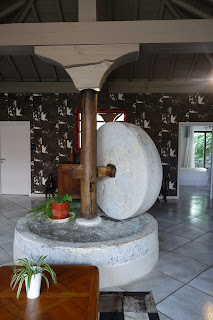Our ancestors, like many other families of Amish descent, worked as farmers on large estates near Montbéliard. Most of these large farms have disappeared, now part of the urban sprawl. However, Le Sainans near the village of Dung has survived as a working farm as well as a place to stay. It dates back to the 1700s. Some of my ancestors worked at this farm. Here is what I have been able to find so far:
In 1823 Christ Guemann's and Marie Guerick's marriage was registered in Dung. Christ was from Étobon, Haute Saône, over 20 kilometres away. My assumption is that the Guerick family lived at Le Sainans. These are our great-great-great grandparents in the Vonier/Aeschlimann line.
In 1824 and 1826, two children were born at Le Sainans to the Aeschlimanns. In 1830 our immigrant ancestor, Christian Aeschlimann, was baptized at age 15 and noted as living at Le Sainans. The Aeschlimann family left Le Sainans sometime between 1830 and 1833 for another farm. They took with them the old Guerick parents who were the maternal grandparents of Christian A. (This line of the Aeschlimanns is related to the Vonier/Aeschlimann line via those Guericks.)
In 1833 a daughter of Joseph Yoder was baptized and noted as being from Le Sainans. Another Yoder daughter, Catherine, married Peter Stuckey in Grandvillars in 1831, so it appears that the Yoders had not yet moved to Le Sainans at that point. This young couple is the immigrant Stuckey couple that is featured at the Sauder Village in Archbold, Ohio: https://saudervillage.org/explore/walk-through-time/pioneer-settlement
My theory is that the Yoder family moved to Le Sainans when the Aeschlimanns left. In 1836 Joseph Yoder was a witness for registering the birth of a son of this young couple in the house of "Sieur Jeanmaire" in Le Sainans. The couple lived in two places prior to Le Sainans and immigrated after the birth of this son, Catherine in 1837 with the sister, Verena Schad Goll, of Peter's two uncles, and Peter prior to that in 1836 or 1837.
Now about the millstone pictured above. It is on display in the lobby of the renovated building with the five B-and-B rooms. I haven't seen any evidence of the Aeschlimanns being millers. But it is a different story in the Stuckey line. Peter Stuckey (mentioned above) had a father who was a miller at Lure, Haute Saône from 1806 or 1807 until he immigrated in 1834. Peter's grandfather and the grandfather's two brothers worked at mills. Peter himself is noted as being a miller on the registration of his marriage and on the birth registration of his first daughter in Froideterre, Haute Saône in 1832.
At Le Sainans, a historical display shows an old layout of buildings. My apologies for the quality of the photos; they are photos of photos behind glass in a dark hallway.
Connecting the two large "barns" was a shed-like structure and a higher part which is called a pigeonnier in the diagram. Pigeons (or sometimes doves) would nest in the upper floors. In former centuries, they were a good source of meat, eggs, and dung. These structures were demolished in the 1990s. The little shed off to the right now serves as an entrance to the courtyard.
There is a dark side to the history to this farm. A new Count, Leopoldo-Eberhard, was in a position where he needed money. I used Google Translate for one of the displays at Le Sainans:
Leopoldo-Eberhard ordered in 1704 enumeration of the lands. The peasants of villages like Dung, who could not produce titles, often disappeared in the wars of the 17th century, were spoiled by a law of desherence of 1710, and these lands were incorporated into the domain of the Count. Then after regrouping with a rigged survey, the count established farms and had them be farmed by Anabaptist farmers.
Google did not translate "desherence", but it relates to people losing the right to dwell on or farm land on which they have been living for years but for which they do not hold a formal title. The Anabaptists were skilled both in raising animals and in farming, whereas the local peasants did mostly farming. Since the Count needed money, he presumably wanted the farms being rented to produce more profitably. Put simply, the Count grabbed the lands through legal but hardly ethical means, and then brought in new workers to improve his economic situation. Fortunately for him, Anabaptists were needing to find new land to rent.
My sources: Joe Springer's translation of the Montbéliard Mennonite Church Register 1750-1958; a birth document that Walter Stuckey was given and is now in the Mennonite Church USA Archives in Elkhart, IN; Robert Baecher's article, "Le domaine de Schoppenwihr et les anabaptistes..." in Souvenance anabaptiste, # 25, 2006, p. 16-42; photos by J. Evan Kreider; États civil (French civil records); the information display at Le Sainans.
Janice























































